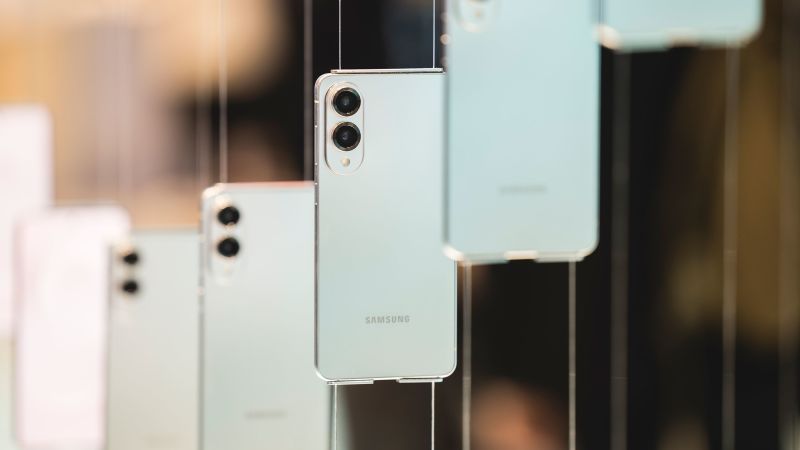New York
CNN
—
There’s a key difference between an iPhone and Samsung Galaxy phone that may matter now more than ever: One was likely assembled in China, while the other was probably produced in Vietnam, India or South Korea.
Samsung, unlike Apple, doesn’t rely heavily on China for smartphone production, a detail that’s become increasingly relevant as the United States and China have been engaged in a tit-for-tat trade war that’s resulted in tariffs on Chinese imports of at least 145% with some exceptions. While Apple has shifted some production to other regions like India, April estimates from Wedbush Securities indicate 90% of iPhone production is still in China.
Smartphones and select other tech devices and parts fall under Trump’s exceptions to reciprocal tariffs, which was viewed as a reprieve for Apple and other phone makers. But the administration also promises that a different bucket of tariffs targeted specifically at semiconductors – the components that power electronics – are coming soon.
Samsung, the world’s largest smartphone maker by market share by some analyst estimates, certainly isn’t immune from tariffs or the economic impact they may bring. But it also doesn’t depend on a country that’s been the biggest target of Trump’s tariff offensive to produce its smartphones, meaning it may not have to upend its mobile device operations in a major way, should tariffs on smartphones from China send prices skyrocketing.
“The advantage is, yes, that they’re not facing the whatever crazy number we are currently dealing with,” said Gerrit Schneemann, a senior analyst for Counterpoint Research covering the smartphone industry.
But that doesn’t mean that Samsung will gain an immediate advantage, Schneemann added.
“At the same time, there’s not a direct line to turning that into just an exponential boost in sales,” he said.
The tech industry relies on China’s vast network of component suppliers and assembly facilities to mass produce consumer devices like smartphones, laptops and monitors. Some of those devices are exempt from reciprocal tariffs, but many gadgets aren’t, including video game consoles and earbuds.
Trade tensions between the two economic powerhouses ratcheted up again on Monday when Beijing threatened reciprocal measures against any country that restricts trade with China to appease the United States. Earlier this month, the Trump administration issued a 90-day pause in reciprocal tariffs against most countries except China.
Analysts at Wedbush Securities, led by managing director Dan Ives, wrote in an April 20 note that negotiations with China need to happen “ASAP” for the sake of “the markets, tech world, and US economy.”
“Otherwise this tariff and trade war will inflict major damage to growth while increasing inflation… and leaving the tech world with many questions and no answers to plan their future strategy,” the note reads.
Apple, given its dependence on China, has been a central focus of the tech industry’s tariff woes, with analysts from UBS estimating the price of an iPhone 16 Pro Max assembled in China could skyrocket by $800. That estimate was made prior to Trump saying that smartphones are exempt from reciprocal tariffs. Just 5% of iPhones are made in Vietnam and India, while another 5% are produced in other countries, according to Wedbush.

The situation is much different for Samsung, which closed its last phone factory in China in 2019 after losing market share to domestic rivals in the country, though it still has other operations there. Sources within Samsung told CNN that the vast majority of its smartphone manufacturing takes place in South Korea, Vietnam, India and Brazil.
That lines up with figures from analysts, as Counterpoint Research estimates 90% of Samsung’s smartphone production is in Vietnam. The International Data Corporation, a market research firm, estimated that roughly 50-60% of Samsung’s smartphone production is based in Vietnam, while India is the company’s second largest phone production hub, with South Korea and Latin America largely making up the rest.
Samsung opened what it called “the world’s largest mobile factory” in India in 2018 and was the largest exporter of smartphones from India in 2024, according to Counterpoint Research, though Apple also has a large presence, with both companies accounting for about 94% of the country’s smartphone exports.
Samsung could also benefit from its dual role as both a seller of consumer electronics and a manufacturer of components like displays, memory and chips, according to Ben Barringer, a global technology analyst for investment management firm Quilter Cheviot.
“Samsung probably has a bit of an advantage in the sense that Samsung is one of the few companies in the world that’s vertically integrated,” said Barringer.
Still, some analysts are skeptical that Samsung’s diversified manufacturing will lead to a boost in sales. Apple customers can be fiercely loyal, and it’s unclear whether price hikes would change that.
“People just aren’t necessarily switching away from Apple to Samsung in general,” said Schneemann.
Linda Sui, senior director of global smartphone strategies for analysis firm TechInsights, also believes Apple will be able to shift production of iPhones destined for the US market to India. The company had reportedly been ramping up iPhone shipments from India to the United States, according to reports from The Financial Times and The Times of India.
Apple and Samsung also cater to different types of smartphone buyers. Apple is known for selling just a few iPhone models, virtually all of them premium devices with higher margins. Samsung, on the other hand, generally sells a wider variety of phones – particularly at the lower end of the price spectrum with its line of Galaxy A series phones, which Schneemann says are Samsung’s “volume drivers.”
“For Samsung, it’s a mixed bag,” he said, as Apple dominates the higher end of the market.
Trump’s tariffs are part of a broader effort to bring manufacturing back to the United States, meaning other nations — including Vietnam and India — also face levies, albeit lower ones of 10% for now, which means Samsung is still likely to be affected by tariffs in some capacity.
But the larger concern is whether the state of the economy could impact consumer spending, possibly dampening demand for smartphones as Trump’s tariffs could potentially raise prices on everything from toys to groceries.
That could push consumers to hold onto their devices for longer periods of time, particularly in mature smartphone markets like the United States, where premium phones tend to be popular, said Schneemann. Demand in emerging markets, where smartphone shipments have seen more growth, could also slow if consumers “feel the pinch,” he said.
“Daily necessities and essentials are going to be higher on the list then maybe a new or upgraded smartphone,” Schneemann said.

